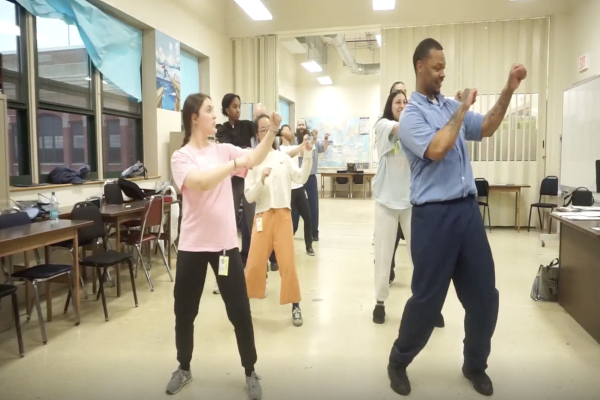Ohio State brings dance, community to prison

Story by Franny Lazarus, Ohio State News
Assistant Professor of Dance Irvin Gonzalez has been passionate about advocacy for as long as he can remember.
“Growing up, I would translate for my parents,” said Gonzalez, whose parents moved to the United States from Mexico. “I’ve always been ready to defend and advocate for people.”
Throughout his career at The Ohio State University, Gonzalez has used dance as a way to connect people, to build community and to tell stories. This past spring, he had a chance to share these passions with a new group of students through the university’s Ohio Prison Education Exchange Project (OPEEP).
Gonzalez taught a class of 21 students, a mix of “outside” students from Ohio State’s Columbus campus and “inside” students from London Correctional Institution (LoCI). OPEEP’s first dance class, Citizen Artists, met for three hours each week, for 16 weeks at the prison. Instead of focusing on technique, Gonzalez chose a less restrictive path, one that allowed students to share their stories through choreography and improvisation.
“I was working with people who are institutionalized,” he said. “They’re already being forced to move in a specific way. A technique class – like a ballet class – there’s a rigidity to it. I wanted to step away from students feeling like someone else was dictating how their body should move.”
OPEEP’s classes are designed to expose students to different ways of thinking, said Mary Thomas, co-director of OPEEP and professor of women’s, gender and sexuality studies.
“Ohio State is known for its high-quality education,” Thomas said. “We want to bring that excellence to incarcerated students. Courses in the arts, like Citizen Artists, challenge students, both inside the prison and from campus, to collaborate and engage with new perspectives. They encourage empathy, develop tools for self-expression and provide outlets for creativity. For incarcerated students, these courses are especially powerful: They guide people along new paths of self-discovery and equip them with enhanced skills for future education, both during their time in prison and beyond."
Students worked alone and together to choreograph dances from both personal stories and written text. This collaborative work helped students and Gonzalez alike overcome their largest hurdle: The prison does not allow touch between people.
“We took time to imagine how to connect without touching. What does it mean to do a partnered, social dance without touching?” he said. “Maybe that’s mirroring each other’s movements, maybe that’s using your voice to move someone else. We also did individual choreography that allowed people to move next to each other, to create energy that way.”
Another barrier Gonzalez and his students navigated was the vulnerability dancing requires. LoCI is a male prison and Gonzalez is familiar with the stigma that can be associated with male dancing.
“There were questions. ‘How much are we going to move?’ ‘What are you going to make us feel?’” he said. “‘I don’t think I’m ready for this.’ ‘I don’t know how the other guys are going to see me.’ It was my job to let them know that we’re building a space where we get to sweat and move with each other in the moment. You can take whatever you want from that.”
This was not Gonzalez’s first time teaching dance in a prison setting. Unlike previous instances, though, he was able to spend weeks with the same students.
“It was such an exciting thing. My previous experiences have been one-offs,” he said. “I got to see a whole semester of growth and cultivation. You had folks from different circumstances coming together to build community. It was powerful.”
In fact, Gonzalez’s students struggled with the idea that they wouldn’t be able to speak with each other once the semester concluded.
“We’ve built this community and then one day, we are to have no more contact with one another,” he said. “My students would ask how we can maintain contact. I had to remind them that we’re not allowed to communicate. The contact lives in the lessons we learned. I take the dance with me for the rest of my life. It lives inside my body; it’s archived inside my body.”
